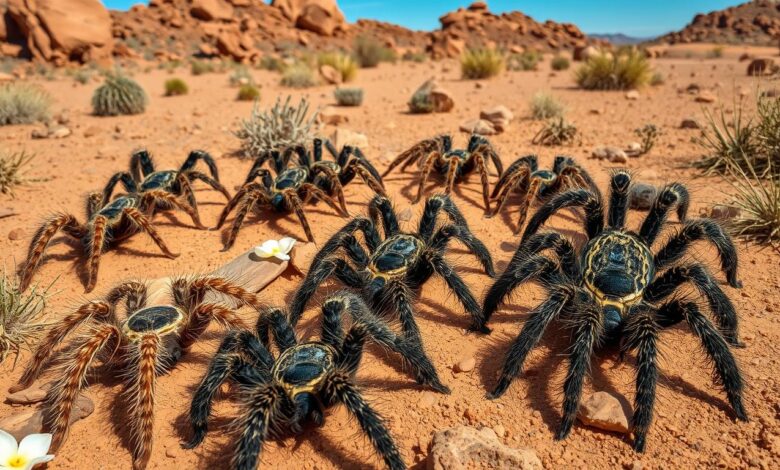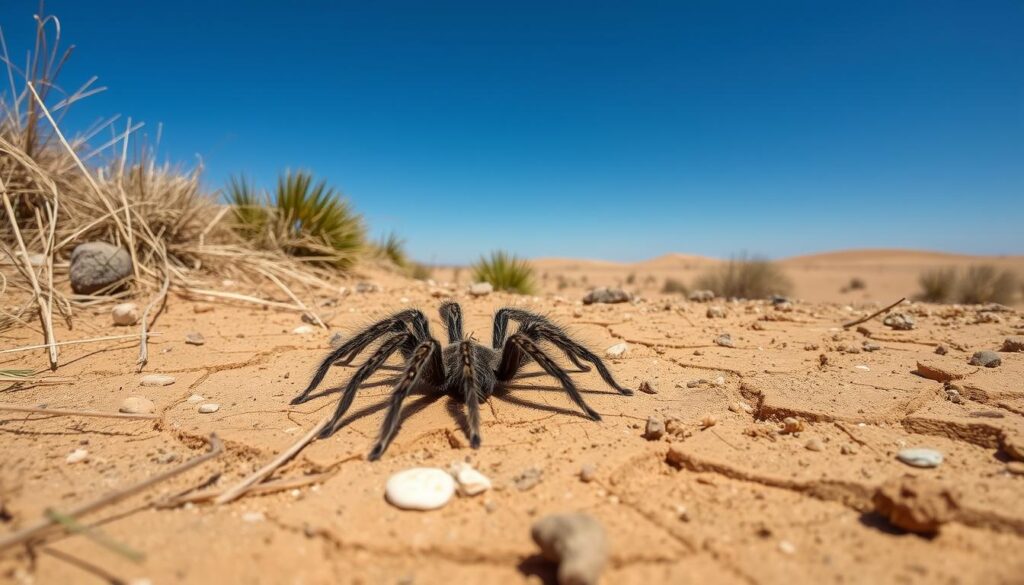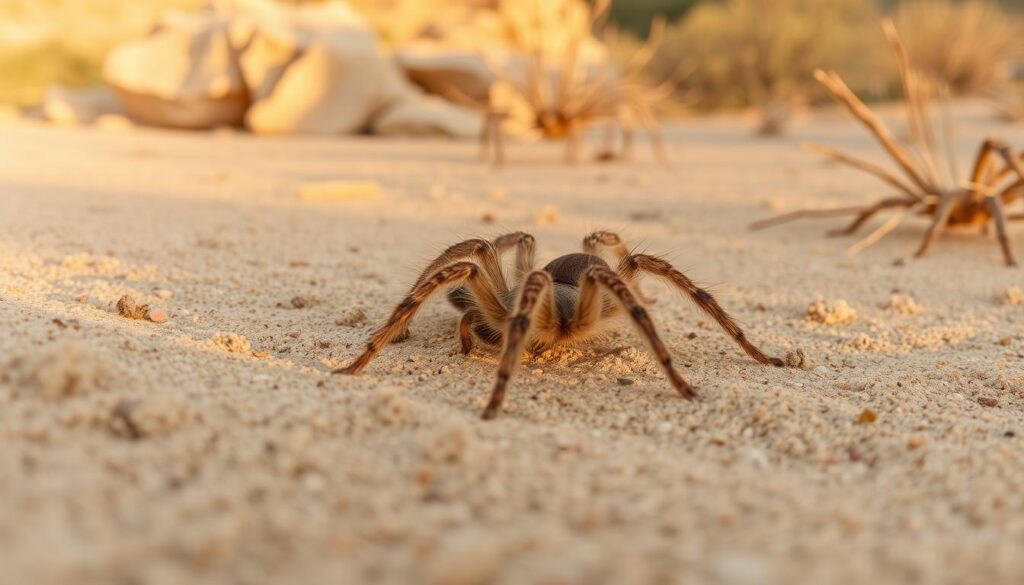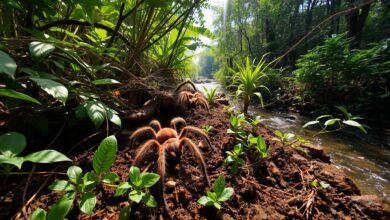Adaptations of tarantulas that live in xerophilous or extremely dry environments

Tarantulas are amazing spiders that live in very dry places. They belong to the mygalomorph spider family. These spiders have special ways to survive and even do well in very dry places like deserts and dry mountains. Let’s explore the secrets behind their success in such tough environments.
Introduction to Tarantulas in Xerophilous Environments
Xerophilous habitats are very dry places with little rain and high heat. Tarantulas live in these areas and have special ways to survive. Learning about these adaptations helps us see how tough these spiders are. It also teaches us about desert and semi-desert ecosystems.
Defining Xerophilous and Arid Habitats
Xerophilous habitats are places where living things must save water and keep cool. They are often deserts or semi-deserts with little rain, high heat, and not much water. Tarantulas have special ways to live in these tough places.
Importance of Studying Tarantula Adaptations
Looking into how tarantulas adapt to dry places is important for many reasons. It helps us understand how these spiders have evolved to survive. It also teaches us more about deserts and semi-deserts and how different species work together. Plus, it could lead to new ideas for saving water or creating new materials inspired by the spiders.

Arid Habitat Adaptations
Tarantulas living in dry, desert-like areas have developed special ways to survive. These adaptations help them save water, control their body temperature, and deal with the desert’s challenges.
They have unique body shapes that help them lose less water. Their bodies are round and small, which cuts down on water loss. Their skin is thick and waxy, which also helps keep water in.
These tarantulas have ways to manage their water and temperature too. They can slow down their metabolism and control how much water they lose. This helps them save water in the dry climate.
They also have behaviors that help them survive. For example, they dig burrows for shelter. These burrows protect them from the hot sun and harsh conditions outside.

Desert-dwelling tarantulas use their body shape, physiology, and behavior to live in tough desert environments. They show how these amazing spiders can adapt and survive in harsh places.
Tarantulas in Xerophilous Environments
Species Diversity in Arid Regions
The variety of tarantula species in xerophilous or arid environments shows how adaptable these spiders are. Each species has found its own way to survive in the tough conditions of deserts and rocky mountains. By studying desert-dwelling spiders, we learn about their strength and flexibility.
In places like Peru’s coastal deserts and northern Chile, there’s not much greenery. But, the high Andes have a cool cloud forest full of life. Up there, you’ll find everything from grasses to cacti, but less as you go higher.
These xerophilous environments have led to many tarantula species that can handle the dryness. From the coast to the mountains, these spiders have special traits to live in places with little water.
| Arid Region | Dominant Vegetation | Tarantula Species Diversity |
|---|---|---|
| Coastal Venezuela, Northeastern Colombia, Southwestern Ecuador, Northern Peru | Thorny shrubs and small trees (Prosopis, Acacia, Mimosa) | Diverse range of adapted tarantula species |
| Coastal Desert, Peru and Northern Chile | Limited vegetation (a few shrubs, terrestrial bromeliads) | Limited but specialized tarantula species |
| High Andes (6,000 – 11,000 feet elevation) | Cloud forest ecosystem (dense epiphytes, undergrowth) | Unique tarantula species adapted to the temperate zone |
| Upper Andean Zones (above 11,000 feet) | Diverse flora (rough grasses, herbaceous plants, shrubs, cacti) | Specialized tarantula species adapted to high-elevation conditions |
The amazing Tarantula species diversity in arid regions shows how these spiders can live in many desert-dwelling places. It’s a sign of their strong ability to adapt.
Water Conservation Strategies
Tarantulas live in very dry places and have found smart ways to save water. They use both behavior and body changes to keep water loss low. This helps them survive in dry areas.
Behavioral Adaptations
Tarantulas dig tunnels underground to live in dry places. These tunnels keep the air around them moist and protect them from dry air. They also stay quiet during the hottest times of the day to save water.
Physiological Mechanisms
Tarantulas have special ways to save water too. Their breathing is very efficient, which means they lose less water. They can also reuse water by taking it back from their own bodies.
Some tarantulas can store water inside themselves. They have special proteins or carbs that hold water for when it’s scarce. This shows how well they’ve adapted to survive in dry places.
Tarantulas use both behavior and body changes to live in dry places. This shows how strong and adaptable these spiders are.
Thermoregulation Mechanisms
Keeping a stable body temperature is key for desert-dwelling tarantulas to survive in dry places. These spiders have developed smart ways to handle big temperature changes.
They pick the right spots to live, like burrows or small spaces, to stay out of the sun’s strong rays. They also move around less during the hottest parts of the day or night. This helps them avoid getting too hot.
Inside their bodies, tarantulas have special circulatory systems to spread and control heat. They also make heat-shock proteins. These proteins help them handle high temperatures and keep their cells safe.
Desert tarantulas use both behavior and body changes to keep their temperature just right. This helps them live and thrive in tough dry environments.
Burrowing Behavior
Tarantulas in dry lands have learned to dig complex burrows. These burrows protect them from harsh weather and provide the right temperature and humidity. This is key for their survival and health.
Burrow Structure and Functions
Different tarantula species dig various burrows, based on their environment. Some dig simple, straight burrows, while others make complex ones with many tunnels. These burrows often have a special entrance to keep predators out.
These burrows are vital for many reasons. They shield tarantulas from extreme heat, dryness, and predators. They are safe places for molting, mating, and raising young. The burrows also help the spiders save water, which is very important in dry places.
Moreover, burrows are perfect for hunting. Tarantulas can catch prey from the safety of their underground homes. The design of the burrow can help the spiders hunt better, increasing their chances of catching food.
Studying tarantula burrowing behavior and burrow structure and functions helps us understand how these spiders survive in tough environments. It shows us their unique ways of adapting and thriving.
Nocturnal Hunters
To avoid the harsh daytime heat and dryness, many tarantulas live at night. They hunt in the dark to save water and energy. They catch insects, small animals, and other spiders. Their sharp senses and hunting skills help them succeed in the desert.
Nocturnal hunters have special traits. Their desert-dwelling spider adaptations include:
- Enhanced sensory perception: Tarantulas have sharp vision, touch, and feel vibrations to find and catch prey at night.
- Stealthy movement: They move quietly, using their hairy legs to hide sounds and slow steps to sneak up on prey.
- Specialized hunting strategies: Tarantulas use different ways to hunt, like ambushing, stalking, and pouncing, to catch prey well.
Living at night helps tarantulas in xerophilous environments to survive and play a key role as top predators. They keep the desert ecosystem balanced.
Venom Properties
Tarantulas living in very dry places have venom that helps them survive. Their venom is made to catch prey like small rodents, birds, or other spiders. The venom also helps them defend against predators in their dry homes.
Role in Prey Capture and Defense
Tarantula venom is full of different substances like neurotoxins, cytotoxins, and enzymes. These substances quickly paralyze their prey, making it easy for the tarantula to eat it. The venom also keeps other animals away, protecting the tarantula from danger.
The venom of tarantulas in dry places has changed over time. It helps them catch food and stay safe in places with little food and tough weather.
Learning about tarantula venom properties and how it helps them catch prey and defend themselves is interesting. It also helps us understand how different animals survive in tough places.
Ecological Roles
Tarantulas are key players in dry environments. They are top predators, controlling the numbers of small animals. This helps keep the balance in these delicate ecosystems.
They also act as ecosystem engineers. By digging, they improve soil and help nutrients move around. This is crucial for the survival of many plants and animals in these areas.
The Importance of Tarantulas in Arid Ecosystems
Tarantulas don’t just live in dry places; they shape them. Their hunting keeps small animal populations in check. This is vital for a healthy ecosystem.
Their digging helps the soil breathe and nutrients spread. This is key for many plants and animals to thrive.
| Ecological Role | Importance in Arid Ecosystems |
|---|---|
| Predation | Regulate populations of smaller animals, maintaining a balanced ecosystem |
| Burrowing | Enhance soil structure and nutrient cycling, supporting diverse plant and animal communities |
Learning about tarantulas’ roles in dry lands helps us protect them. It also helps us keep their unique ecosystems safe.
Research Frontiers and Conservation Efforts
The study of tarantulas in xerophilous environments is a key area of research. Scientists are looking into their adaptations, behaviors, and how they fit into their ecosystems. With threats like climate change and human actions, protecting tarantulas and their homes is more urgent than ever.
Research on tarantulas in xerophilous environments is vital. It helps us understand how these spiders live in dry places. By studying their biology and behavior, scientists can help protect them and their homes.
Working together is key to saving tarantulas and their habitats. Conservation efforts bring together researchers, policymakers, and local communities. They work on protecting habitats, watching over species, and teaching the public about the importance of these creatures.



